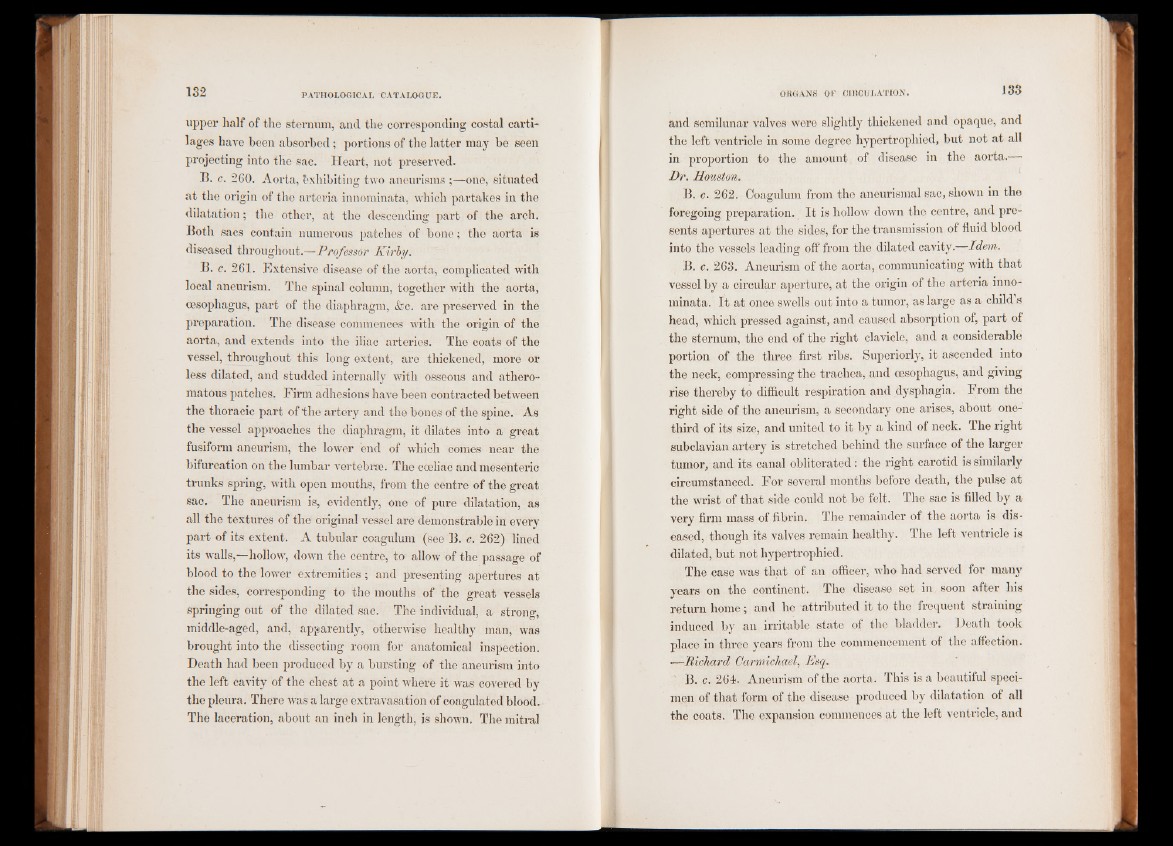
upper half of the sternum, and the corresponding costal cartilages
have been absorbed; portions of the latter may be seen
projecting into the sac. Heart, not preserved.
B. c. 260. Aorta, Exhibiting two aneurisms ;—one, situated
at the origin of the arteria innominata, which partakes in the
dilatation; the other, at the descending part of the arch.
Both sacs contain numerous patches of bone; the aorta is
diseased throughout.—Professor Kirby.
B. c. 261. Extensive disease of the aorta, complicated with
local aneurism. The spinal column, together with the aorta,
oesophagus, part of the diaphragm, &c. are preserved in the
preparation. The disease commences with the origin of the
aorta, and extends into the iliac arteries. The coats of the
vessel, throughout this long extent, are thickened, more or
less dilated, and studded internally with osseous and atheromatous
patches. Firm adhesions have been contracted between
the thoracic part of the artery and the bones of the spine. As
the vessel approaches the diaphragm, it dilates into a great
fusiform aneurism, the lower "end of w’hich comes near the
bifurcation on the lumbar vertebrae. The cceliac and mesenteric
trunks spring, with open mouths, from the centre of the great
sac. The aneurism is, evidently, one of pure dilatation, as
all the textures of the original vessel are demonstrable in every
part of its extent. A tubular coagulum (see B. c. 262) lined
its walls,—hollow^, down the centre, to allow of the passage of
blood to the lower extremities ; and presenting apertures at
the sides, corresponding to the mouths of the great vessels
springing out of the dilated sac. The individual, a strong,
middle-aged, and, apparently, otherwise healthy man, was
brought into the dissecting room for anatomical inspection.
Death had been produced by a bursting of the aneurism into
the left cavity of the chest at a point where it was covered by
the pleura. There was a large extravasation of coagulated blood.
The laceration, about an inch in length, is shown. The mitral
and semilunar valves were slightly thickened and opaque, and
the left ventricle in some degree hypertrophied, but not at all
in proportion to the amount of disease in the aorta.—
Dr. Houston.
B. o. 262. Coagulum from the aneurismal sac, shown in the
foregoing preparation. It is hollow down the centre, and presents
apertures at the sides, for the transmission of fluid blood
into the vessels leading off from the dilated cavity.—Idem.
B. c. 263. Aneurism of the aorta, communicating with that
vessel by a circular aperture, at the origin of the arteria innominata.
It at once swells out into a tumor, as large as a child’s
head, which pressed against, and caused absorption of, part of
the sternum, the end of the right clavicle, and a considerable
portion of the three first ribs. Superiorly, it ascended into
the neck, compressing the trachea, and oesophagus, and giving
rise thereby to difficult respiration and dysphagia. From the
right side of the aneurism, a secondary one arises, about one-
third of its size, and united to it by a kind of neck. The right
subclavian artery is stretched behind the surface of the larger
tumor, and its canal obliterated: the right carotid is similarly
circumstanced. For several months before death, the pulse at
the wrist of that side could not be felt. The sac is filled by a
very firm mass of fibrin. The remainder of the aorta is diseased,
though its valves remain healthy. The left ventricle is
dilated, but not hypertrophied.
The case was that of an officer, who had served for many
years on the continent. The disease set in soon after his
return home; and lie attributed it to the frequent straining
induced by an irritable state of the bladder. Death took
place in three years from the commencement of the affection.
•—Richard Carmichael, Esq.
' B. c. 264. Aneurism of the aorta. This is a beautiful specimen
of that form of the disease produced by dilatation of all
the coats. The expansion commences at the left ventricle, and